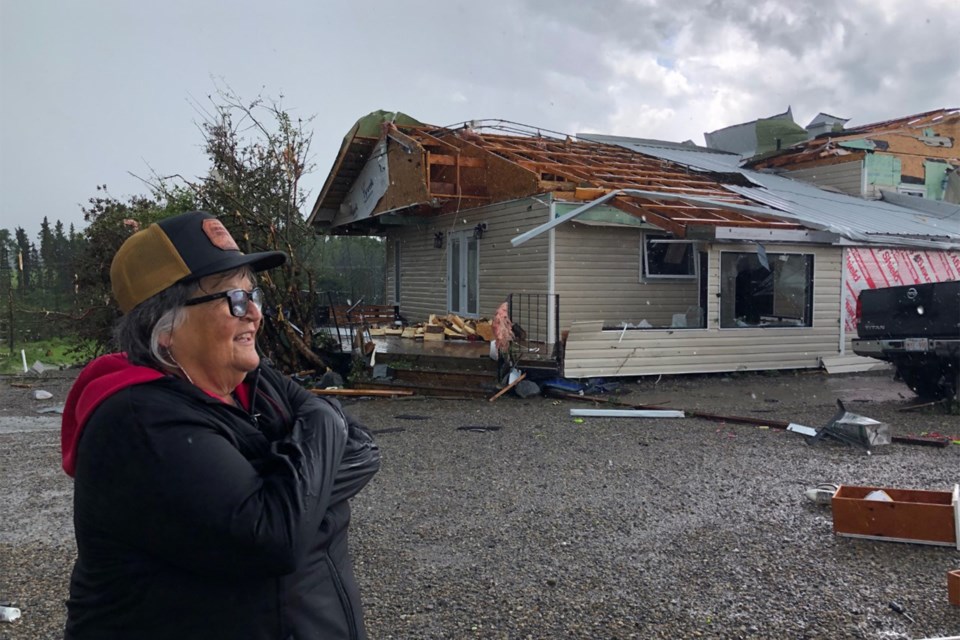MOUNTAIN VIEW COUNTY — County officials did not delay investigating whether funding might be available through the provincial government’s Disaster Recovery Program in the wake of the devastating July 7 storm that produced a twister, Mountain View County's reeve said.
However, Angela Aalbers, who is also the Division 5 representative, said Mountain View County was as of last week still waiting to hear back from the ministry of Municipal Affairs.
“The county started looking into the Disaster Recovery Program funding right after the tornado,” Aalbers told the Albertan.
“So, probably the next day, our staff had already started to contact the Alberta Emergency Management Agency to discuss how we would go about submitting applications.”
While the municipality sustained some losses that insurance will not cover, the damages paled in comparison to what a number of residents in the Bergen area experienced, she said.
“The county has had uninsurable losses from trees falling in the ditch and in some issues that we’ve had to deal with the roads and such. But not to the degree that the private landowners have had,” she said.
And as the provincial program is primarily intended to assist municipalities, private residents are unable to directly apply for funding, she said.
“How the DRP works is private residents can’t actually apply for the fund unless a municipality applies first” and is subsequently approved through the ministry, she elaborated.
“Our main purpose of working through the DRP was to allow or provide access for our landowners and our taxpayers within the county of Mountain View to actually access that disaster recovery plan funding,” she said.
Asked what county council is hoping to get out of any assistance made available through the program, Aalbers said officials’ first hope is for the provincial government to determine a natural disaster indeed unfolded, which in turn would potentially open the door to accessing the program’s funds.
“That’s our first step. The county has submitted all the documents. We have done everything that we have been required to do with respect to the process of the funding,” she said.
“We are just now waiting on a response in order to get approval to access that funding. Once we get that approval. Then, the province and the county will work with private landowners in order to help them fill out the applications.”
However, there are no definitive timelines.
“The biggest frustration is landowners just want to know what they’re entitled to and what the support they can expect from the province is,” she said, empathizing with their difficult situation.
“This is a provincial funding mechanism – it is a provincial program, and we are trying to work through the red tape as quickly as we can on behalf of our landowners,” she said. “But we completely understand the frustration that they are feeling in the delayed timelines to get a response.”
As the application for emergency financial relief is through a provincial program and the county is just following that process, no motion of council was required, she said.
“The big issue on this – and I think this is important – is the tornado is an unusual event for Alberta,” she said. “And so, I think that the province is struggling to find out how impacted landowners can access the Disaster Recovery Program for a tornado, because it is not a regular occurrence.”
As such, and in the absence of another emergency relief program, the reeve was cautiously optimistic about what, if anything, might be offered to landowners through the DRP.
“Debris removal for grazing lands, the impact of the complete destruction of all of those trees being blown down by the tornado and the fencing, is not covered by insurance but doesn’t seem to fall under any provincial program,” she said.
“This is really ground breaking I think, for municipalities to try and figure out how to navigate through the Disaster Recovery Program.”
One way or another and regardless of whether funding is approved, the reeve said county council fully intends to follow-up with the provincial government.
“This is something we absolutely will be conveying back to Municipal Affairs,” she said. “We plan to do an after-action review on the DRP.”
County officials intend to highlight to the provincial government where the program might be improved, including clarifying confusion on how and when to access the program, and if it’s even available for natural disasters such as tornadoes.
“If not, then we will be advocating to the province in order to create new programs that are more accessible, that are more nimble and that are faster for landowners to access,” she said. “They just want to get back their lives and livelihoods.”
Efforts to communicate and engage with impacted landowners must also be improved, she said.
“When you’re a landowner with a level of destruction that our residents have had to live through, an hour is too much without information,” she said. “We understand the urgency. We’re just working within the process, and the process is painfully slow.”
The Bergen tornado was given an EF-2 rating – zero being the weakest and five the strongest – by Environment and Climate Change Canada, which can mean winds ranging between 180 to 220 kilometres per hour. The Bergen tornado’s wind speeds were estimated at approximately 180 to 190 kilometres per hour.
In response to an email inquiry about the estimated cost of damages based on filed claims, a spokesperson from the Insurance Bureau of Canada’s Edmonton office told the Albertan earlier in August the storm was designated a catastrophe by the Catastrophe Indices and Quantification Inc.
As such, they said insured losses were expected to exceed $30 million, adding that amount is not specific to the properties in the Bergen area alone, but rather the entire region the severe weather event swept through.
“However, those regions (around Bergen) would be captured as part of that event.”


